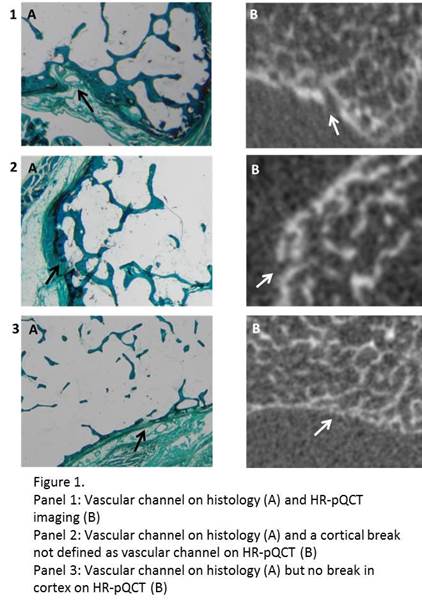Session Information
Session Type: ACR Poster Session B
Session Time: 9:00AM-11:00AM
Background/Purpose: Several studies have indicated that High Resolution peripheral CT (HR-pQCT) scanning is more sensitive than radiography in detecting cortical interruptions in destructive joint diseases like rheumatoid arthritis (RA)[1-3]. Cortical interruptions are also seen in healthy controls, but the exact nature of these interruptions is not known, and might represent vascular channels (VCs). No previous study has compared histology to HR-pQCT images in finger joints. We hypothesized that VCs seen on histology can also be detected by HR-pQCT imaging.
Methods: Based on HR-pQCT, 4 regions in 3 metacarpophalangeal (MCP) joints from female cadavers with an unknown medical history (mean age 84.7, SD 5.5 years) were selected. These regions were extracted, embedded undecalcified in methylmetacrylate and histologically sectioned (thickness 14μm) parallel to the axial plane. Every second section (n=478) was stained with Goldner Trichrome. VCs were identified as a cortical interruption in one histological section, which contained one or more vessels. Histological sections were matched visually to corresponding axial HR-pQCT images. Per match, it was described if a cortical interruption was observed on HR-pQCT and if this was a VC based on an interruption with a parallel structure present on 2 consecutive slices in 2 planes (axial, and/or sagittal/coronal).
Results: A total of 52 different VCs were identified on histology. All could be matched to a corresponding axial HR-pQCT image. Twenty histologically defined VCs would be defined as VC on HR-pQCT based on the parallel structure, although only 5 were present on 2 consecutive slices and 15 on less than 2 consecutive slices. Twenty-seven interruptions were observed on HR-pQCT, but did not fulfill the definition of a VC. In 5 cases no interruptions could be observed on HR-pQCT. Figure 1 demonstrates 3 examples of histology and matching HR-pQCT images.
Conclusion: VCs were frequently present in MCP joints. Only a minority of histologically defined VCs is interpreted as VC using a pre-specified definition on HR-pQCT images. Small histological VCs were often identified as an interruption but rarely considered a VC on HR-pQCT. Therefore, additional criteria in order to categorize a VC as such on HR-pQCT are warranted.
References.1.Stach 2010 2.Srikhum 2013.3.Fouque-Aubert 2010
To cite this abstract in AMA style:
Scharmga A, Keller KK, Peters M, van Tubergen A, van den Bergh J, van Rietbergen B, Weijers R, Loeffen D, Hauge EM, Geusens P. Can Histologically Defined Peri-Articular Vascular Channels be Identified on High-Resolution Computed Tomography? – a Study in Cadaveric Finger Joints [abstract]. Arthritis Rheumatol. 2016; 68 (suppl 10). https://acrabstracts.org/abstract/can-histologically-defined-peri-articular-vascular-channels-be-identified-on-high-resolution-computed-tomography-a-study-in-cadaveric-finger-joints/. Accessed .« Back to 2016 ACR/ARHP Annual Meeting
ACR Meeting Abstracts - https://acrabstracts.org/abstract/can-histologically-defined-peri-articular-vascular-channels-be-identified-on-high-resolution-computed-tomography-a-study-in-cadaveric-finger-joints/

